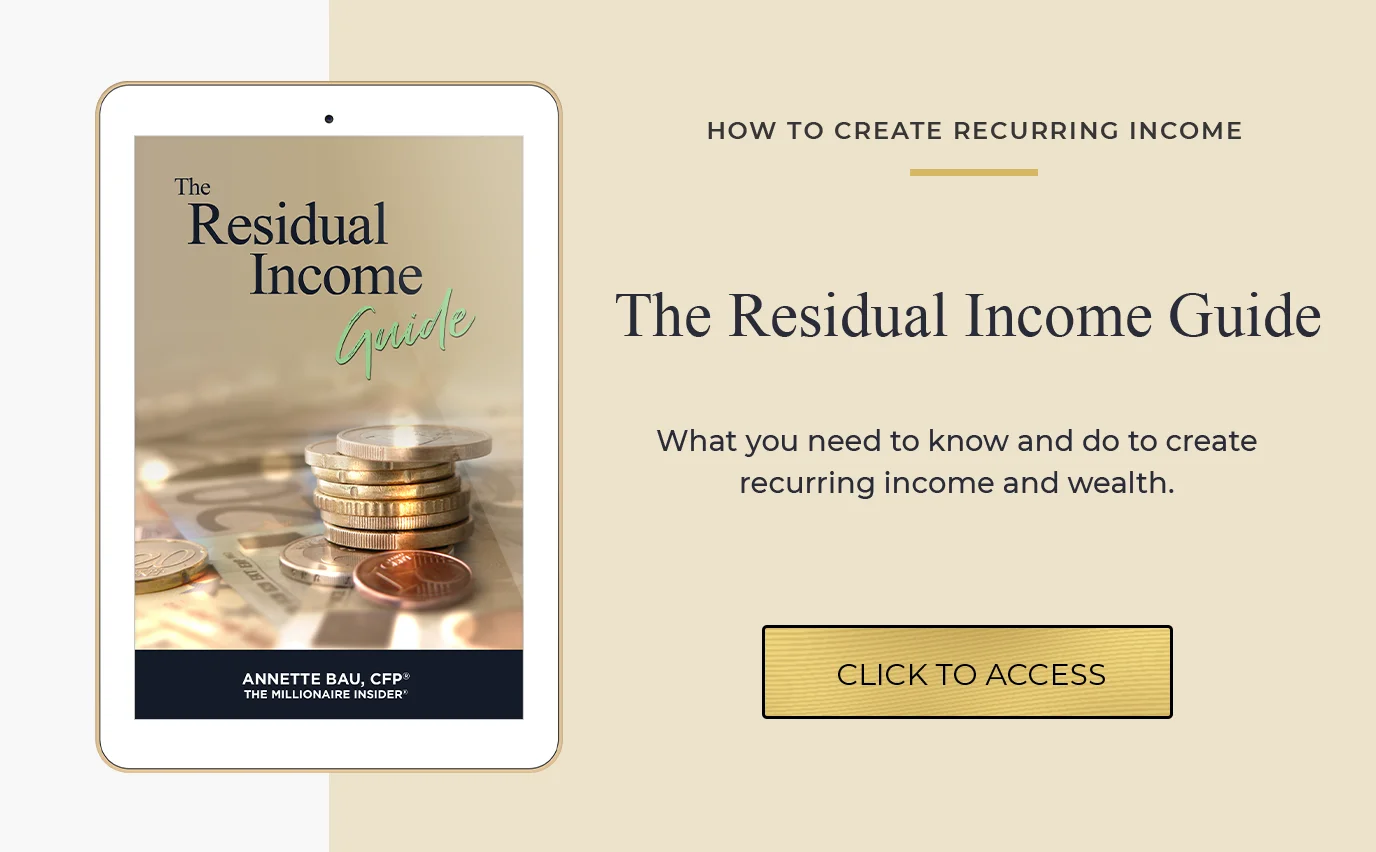
Building wealth can be fun and easy.
The first step is to create a plan, the second is to monitor your strategy and process, and the third is to evaluate and tweak it if needed.
Growing wealth means creating long-term income streams through multiple sources. While you may think of income as what you earn from a job, consider the wealth you can grow from savings, investments, and income-generating assets.
Accumulating and growing your net worth is a critical component of a successful financial plan and is essential for creating a financially free life you love. This is because it allows you to generate passive income so you can spend your time doing whatever you choose.
7 Steps to Building Wealth
1. Start Building Wealth
The best time to begin is yesterday, and the next best time is right now. Instead of beating yourself up for not starting earlier, commit to creating your plan by following these seven steps to make it a reality.  While most people want to start investing, it is vital that you first create a financial plan.
While most people want to start investing, it is vital that you first create a financial plan.
2. Create a Financial Plan
Developing an overall financial strategy is critical to building wealth. A comprehensive plan will guide you in creating an emergency reserve and a plan for unforeseen risks that can potentially threaten your finances.
Specifically, your plan will help ensure you have adequate property & casualty insurance,disability, life, and long-term care insurance, as well as an umbrella policy if needed.
This will also help you save for retirement, reduce your tax bill, and develop an estate plan. This is critical to anyone’s long-term financial success.
A properly devised financial plan will also guide you in the following areas:
- Identifying your financial goals
- Paying off debt
- Building a good credit score
- Understanding interest rates
- Replacing high-interest credit cards with a plan only to charge what you can pay off each month
- Devising strategies to increase the amount of money you are saving and investing, including funding your retirement accounts
- Creating a long-term investment strategy with retirement and savings accounts, such as a Roth IRA
3. Making & Saving Money

The first step in building wealth requires that you make money. This is income you will likely earn from a job but also includes side hustles, such as affiliate marketing or a home-based business. The key is to save money from the income you earn. This is the first step to accumulating wealth.
Too often, people focus on earning or making money but never begin saving. As you can imagine, this often leads to disaster.
There is a big difference between being rich vs. wealthy. Rich people earn and spend a lot of money, while wealthy people accumulate assets and create multiple income streams.
The first step is to save enough money in an emergency fund. You can place this cash or equivalent in a high-yield savings account. Generally, this should cover six months of expenses.
Now that you have funded your emergency reserve and are hopefully also paying down your debt (if you have any), the next step is to start investing your excess money into assets like the stock market.
Before you start with “I don’t have enough money,” or “I will start in a few months,” or whatever excuse pops up, read, re-read, and take action on the next step.
4. Master Your Mindset
For some, this may seem hard to understand. You want to start building wealth, not working on your mindset. If you have not already created your plan and begun saving and investing, it may not be as easy as you want to believe. Before you beat yourself up, you need to understand how your brain works and why this happens.
Your subconscious, limbic, old brain (whatever you want to call it) hates to change, and it is there to protect you and conserve calories. It has no desire to change anything. On the other hand, your prefrontal cortex is excited and ready to start.
The problem is that if your subconscious mind and conscious mind are not on the same page, the odds are that your subconscious mind will win. And the result is that you do nothing and continue to get the same results.
And while it may seem like no big deal in the short term, it will be a big deal when you are broke in retirement or have to work until you are 70 or older.
5. Invest and Create Wealth
Once you create your plan, fund your emergency reserve, and focus on making and saving money, you are ready to start building wealth. 
This step entails that you create an investment plan. This will help you get clear on your goals, risk tolerance, and timetable.
If you can afford to hire a financial advisor for personal finances, do so. Or, if that is not an option, seek support from the company you plan to invest with. If they do not have a risk assessment or can’t provide you with guidance, then find a different firm. Most major firms offer support and guidance to ensure your investment portfolio is consistent with your time horizon and risk tolerance.
If you have specific questions about building wealth, click here.
My Success Secrets for Building Wealth
Lastly, I attribute three things to my financial success.
First, I began investing $25 per month over thirty-five years ago.
At the time, I was a single parent, watching every penny I spent, and I didn’t have any extra money to save or invest.
Second, I worked extensively on my mindset, and third, I created luck in my life. Each day, I did the required work regardless of how I felt.
Let’s review the process so you can achieve your goal.
The first essential step is determining what you want to accomplish – more than anything else. Second, you must decide why you want to achieve it, including your intention for accomplishing it.
Finally, determine how accomplishing the goal will make you feel. Those three steps are critical to success. Once the initial excitement wanes, people often give up on their goal.
Their limbic brain realizes they are shifting old habits and beliefs, and because this can be challenging and even hard, it starts to fight back and work against them. As a result, they feel sad, depressed, or even overwhelmed and often stay stuck. They focus on how they feel instead of how they want to feel once their dream becomes a reality.
This, my friend, is a million-dollar nugget that can change your life, so write it down and put it where you will see it every day!
Free Resource for Building a Wealth
If you need help with your mindset, click here:

6. Celebrate Your Wins

Before creating and implementing your plan, decide on a reward for achieving your goal. For example, you decide to do something you enjoy, such as going to dinner with friends, getting a massage, taking a mini vacation, or playing golf.
You can also determine a consequence for not sticking to your commitments. This could be donating to a political party or special interest group you do not like. Some people prefer positive consequences (like me), and some people work better when faced with negative ones.
7. Monitor and Tweak Your Plan
Once you create and implement your plan,  take a minute to determine when you will monitor and review it and make tweaks based on your situation, as well as outside circumstances like the economy, political matters, etc.
take a minute to determine when you will monitor and review it and make tweaks based on your situation, as well as outside circumstances like the economy, political matters, etc.
How to Build Wealth from Nothing
A common question is where to start or how to begin if you do not have any assets or savings. The goal is to start, regardless of the action you take.
If you don’t have enough money to start investing, consider strategies, including ones you have not considered. Some ideas may include:
- Ask for a raise.
- Find a new job or career that pays more.
- Find a side hustle. Examples include a part-time job, home-based business, online venture, or affiliate marketing.
How to Build Generational Wealth

Most people want to build wealth to help their families, including their children and grandchildren. Here are five steps to help you create generational wealth.
- Invest in yourself and your family.
- Start saving early and often.
- Live below your means and avoid debt, especially consumer debt like credit cards.
- Invest in appreciating assets, such as real estate, stocks, businesses, etc.
- Give back and support others on their journey to building wealth (What goes around comes around!).
- Leaving an inheritance with life insurance.
Following these simple tips, you can start building generational wealth that will benefit your family for years.
Building Wealth Conclusion
The first step is to start, which includes creating a plan you can follow so you know where you are going and how to reach your desired destination best.
Start improving your mindset and programming your mind and put “making and saving money” at the top of your list.
Finally, create your investment plan by determining your financial goals, time frame, and risk tolerance.
And finally, create your estate plan to ensure your assets pass as you desire.
Remember to set positive or negative consequences for completing the tasks required to implement your strategy and set time aside to monitor and review your plan.
If you are serious about building wealth and residual income, click here:
